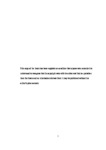Nitrite and insulin lower the oxygen cost of ATP synthesis in skeletal muscle cells by pleiotropic stimulation of glycolysis
| dc.contributor.supervisor | Affourtit, Charles | |
| dc.contributor.author | Donnell, Rosie | |
| dc.contributor.other | Faculty of Health | en_US |
| dc.date.accessioned | 2022-02-28T11:53:56Z | |
| dc.date.available | 2022-02-28T11:53:56Z | |
| dc.date.issued | 2022 | |
| dc.identifier | 10444220 | en_US |
| dc.identifier.uri | http://hdl.handle.net/10026.1/18863 | |
| dc.description.abstract |
Dietary nitrate lowers the oxygen cost of submaximal exercise, but precise mechanistic insight into how this occurs is lacking. Research suggests that dietary nitrate may render oxidative ATP synthesis more efficient, but evidence is inconclusive at present. This thesis aimed to establish how nitrite (a reduced form of nitrate) affects the bioenergetics of cultured skeletal muscle cells. Comparison between the acute effects of nitrite and insulin, a hormonal regulator of muscle function that increases mitochondrial efficiency, was explored to assess possible mechanistic overlap. Calculation of real-time intracellular ATP synthesis rates from simultaneous oxygen consumption and medium acidification measurements revealed the effects of sodium nitrite and insulin on intact rat (L6) myoblasts and myotubes. These extracellular flux data were also used to determine how mitochondrial and glycolytic ATP supply is used to fuel ATP-demanding processes. The data presented in this thesis revealed that both nitrite and insulin acutely stimulate glycolytic ATP synthesis. This stimulation occurs without significant mitochondrial ATP supply changes, thus increasing the glycolytic index of myocytes. Consequently, nitrite and insulin lower the oxygen cost of cellular ATP supply. Notably, insulin lowers oxygen consumption linked to mitochondrial proton leak, thus increasing mitochondrial efficiency. Nitrite does not improve coupling efficiency in myoblasts or myotubes. Further investigations revealed that stimulation of glycolytic ATP supply is not secondary to increased glucose availability. In myotubes, glycolytic stimulation persists in the presence of a mitochondrial uncoupler, suggesting that glycolysis is increased directly. In myoblasts, stimulation is annulled by uncoupler, suggesting that glycolysis increases indirectly, via increased ATP consumption. The molecular targets of nitrite and insulin remain unclear, but the data exclude stimulation of protein synthesis. Together, the data demonstrate that nitrite and insulin lower the oxygen cost of ATP synthesis in skeletal muscle cells by pleiotropic stimulation of glycolysis. The data inform the ongoing debate regarding the mechanism by which dietary nitrate lowers the oxygen cost of exercise, suggesting a push toward a more glycolytic phenotype. Such mechanistic insight is crucial for achieving the full translational potential of dietary nitrate. | en_US |
| dc.language.iso | en | |
| dc.publisher | University of Plymouth | |
| dc.subject | ATP | en_US |
| dc.subject | Mitochondria | en_US |
| dc.subject | Bioenergetics | en_US |
| dc.subject | Nitrite | en_US |
| dc.subject | Nitrate | en_US |
| dc.subject | Insulin | en_US |
| dc.subject.classification | PhD | en_US |
| dc.title | Nitrite and insulin lower the oxygen cost of ATP synthesis in skeletal muscle cells by pleiotropic stimulation of glycolysis | en_US |
| dc.type | Thesis | |
| plymouth.version | publishable | en_US |
| dc.identifier.doi | http://dx.doi.org/10.24382/635 | |
| dc.rights.embargoperiod | No embargo | en_US |
| dc.type.qualification | Doctorate | en_US |
| rioxxterms.version | NA |
Files in this item
This item appears in the following Collection(s)
-
01 Research Theses Main Collection
Research Theses Main


